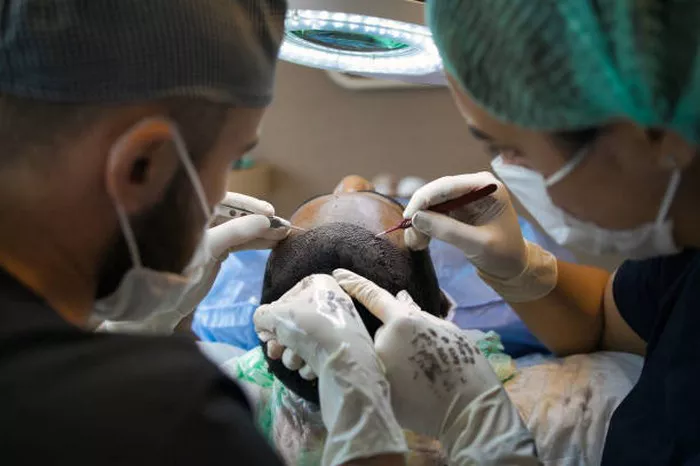Hair transplant surgery is a life-changing procedure for many people struggling with hair loss. However, the journey to a full head of hair doesn’t end in the operating room. Post-operative care is crucial, and one of the most common concerns patients have is about scabs. When do hair transplant scabs fall off? How should you care for your scalp during this time? This guide will answer all your questions.
What Are Hair Transplant Scabs?
After a hair transplant, scabs form on the scalp as part of the natural healing process. These scabs are a combination of dried blood, plasma, and tissue fluids that protect the newly implanted hair follicles. While they may look concerning, scabs are a normal part of recovery and play a vital role in safeguarding the grafts.
Why Do Scabs Form?
Scabs form because the scalp undergoes minor trauma during the transplant procedure. Tiny incisions are made to implant the grafts, and these wounds need time to heal. The body’s natural response is to form scabs to prevent infection and promote healing.
The Hair Transplant Healing Timeline
Understanding the healing timeline can help you know what to expect and when.
Here’s a breakdown of the stages:
Day 1-3: Immediate Post-Transplant Care
In the first few days after the procedure, your scalp will be tender, and you may notice redness and swelling. Scabs will begin to form as the wounds start to heal.
Day 4-7: Scab Formation
By this stage, scabs will be fully formed. It’s essential to follow your surgeon’s instructions for cleaning and caring for your scalp to avoid disturbing the grafts.
Day 8-14: Scabs Begin to Fall Off
This is when most patients start to see scabs falling off. The timing can vary depending on individual healing rates and how well you follow post-op care guidelines.
Week 3-4: Complete Scab Removal
By the end of the first month, most scabs should have fallen off naturally. Your scalp will look cleaner, and the transplanted hair will begin to settle.
When Do Hair Transplant Scabs Fall Off?
The million-dollar question: when do hair transplant scabs fall off? Generally, scabs start to fall off between 7 to 14 days after the procedure.
However, this timeline can vary based on factors like:
Healing Rate: Some people heal faster than others.
Aftercare: Proper cleaning and care can speed up the process.
Graft Type: FUT (Follicular Unit Transplantation) and FUE (Follicular Unit Extraction) may have slightly different healing times.
Can You Speed Up the Process?
While you can’t rush natural healing, you can take steps to ensure scabs fall off on time:
Follow Cleaning Instructions: Gently wash your scalp as advised by your surgeon.
Avoid Picking Scabs: Picking can damage grafts and delay healing.
Stay Hydrated: Proper hydration supports overall healing.
How to Care for Your Scalp During Scab Formation
Proper care is crucial to ensure scabs fall off without complications.
Here’s what you need to do:
1. Gentle Washing
Your surgeon will provide specific instructions for washing your scalp. Typically, you’ll start washing your hair 2-3 days after the procedure. Use a mild shampoo and avoid scrubbing the scabs.
2. Avoid Touching or Scratching
It’s tempting to touch or scratch your scalp, but this can dislodge grafts and delay healing. Keep your hands away!
3. Moisturize as Directed
Some surgeons recommend applying a saline solution or moisturizer to keep the scabs soft and prevent itching.
4. Protect Your Scalp
Avoid direct sunlight, hats, or anything that could irritate your scalp during the healing process.
What Happens If Scabs Don’t Fall Off?
In most cases, scabs fall off naturally within two weeks.
However, if scabs persist beyond this period, it could indicate:
Improper Cleaning: Not washing your scalp enough can cause scabs to harden and stick.
Infection: Redness, swelling, or pus may signal an infection.
Dry Scalp: Lack of moisture can make scabs harder to remove.
If you’re concerned, contact your surgeon for advice.
Common Myths About Hair Transplant Scabs
There’s a lot of misinformation about scabs and hair transplants.
Let’s debunk some common myths:
Myth 1: Scabs Mean the Grafts Are Falling Out
Scabs are a natural part of healing and do not indicate graft failure. The grafts are securely implanted beneath the scabs.
Myth 2: Picking Scabs Helps Healing
Picking scabs can damage grafts and lead to scarring or infection. Always let scabs fall off naturally.
Myth 3: Scabs Are a Sign of Poor Surgery
Scabs are a normal part of the healing process and are not related to the quality of the surgery.
Tips for a Smooth Recovery
To ensure a smooth recovery and optimal results, follow these tips:
Attend Follow-Up Appointments: Your surgeon will monitor your progress and address any concerns.
Eat a Healthy Diet: Nutrient-rich foods support healing.
Avoid Strenuous Activities: Heavy exercise can increase blood flow to the scalp and disrupt healing.
Be Patient: Hair growth takes time, and results will gradually improve over several months.
When to Expect Visible Results
While scabs fall off within a few weeks, visible hair growth takes longer.
Here’s what to expect:
Month 1-3: The transplanted hair may shed, which is normal.
Month 4-6: New hair begins to grow.
Month 12: Full results are visible, with thicker, natural-looking hair.
Conclusion
Hair transplant scabs are a temporary part of the healing process. By following your surgeon’s instructions and taking proper care of your scalp, you can ensure a smooth recovery and achieve the best possible results. Remember, patience is key, and the wait will be worth it when you see your new hair!
If you have any concerns during your recovery, don’t hesitate to reach out to your medical team. They’re there to help you every step of the way.
Related topic:

